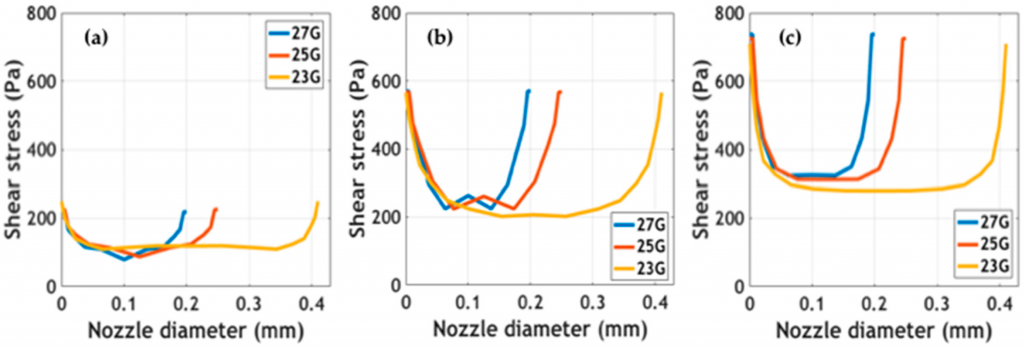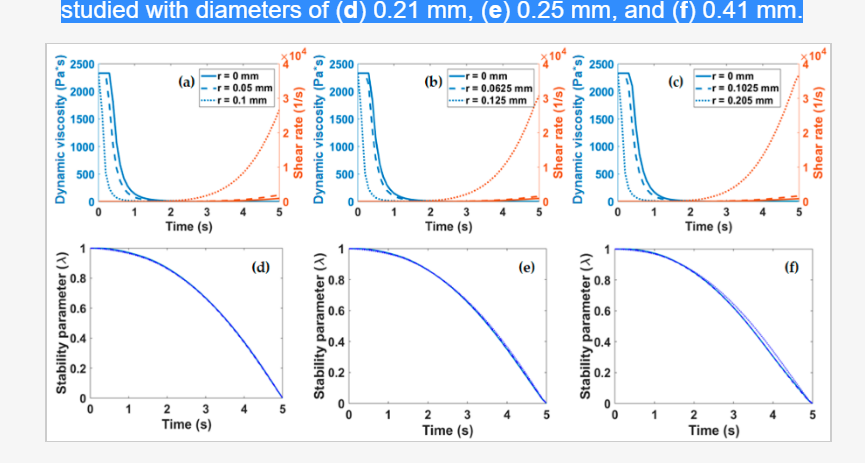
(a) Preparation of the 0.5% (w/v) riboflavin (RF) bioink and (b) its successful extrusion through a 21 G needle. (c) Filament formation during extrusion of the bioink through a 21 G needle. (d) Presumed photo-mediated crosslinking reaction thought to be occurring in the proposed bioinks.
Colombian researchers performed a recent study, outlined in ‘Formulation and Characterization of a SIS-Based Photocrosslinkable Bioink,’ explaining the possible value in crosslinking to create better materials for 3D printing cells. Here, they are using small intestinal submucosa (SIS) with photocrosslinked reactions to manipulate the gelation process, despite some expected challenges.
While the use of natural materials is always preferable, the researchers point out that they can also be difficult to work with due to lack of strength and stability. In the end that leads to inferior printability and further challenge.
“An avenue through which to overcome these issues is to mix them with synthetic polymers such as polyethylene glycol (PEG), polylactic acid (PLA), and polycaprolactone (PCL), which have demonstrated their ability to alter the mechanical response upon blending,” state the researchers. “Additionally, they have been proven able to shorten degradation rates, though at the expense of decreasing their biocompatibility.”
The authors also began to study decellularized extracellular matrices (dECMs) further, as they have the potential to copy the natural cellular environment. dECMs include the following proteins:
- Collagen
- Elastin
- Laminin
- Glycosaminoglycans
- Proteoglycans
- Growth factors
dECMs are not always stable though, and that presents challenges in bioprinting:
“Despite these obstacles, several research groups worldwide have attempted the development of bioinks based on dECMs,” state the researchers. “For inducing gelation, these studies have incorporated thermally-induced or photocrosslinking mechanisms, as well as a combination of the two.”
“Despite the crosslinking strategy implemented, the achieved mechanical stability has been observed to still not be sufficient, thereby requiring the use of synthetic materials as structural improvement supports.”

Shear stress profiles of the bioinks at different nozzle diameters and extrusion pressures: (a) 10 kPa, (b) 20 kPa, and (c) 60 kPa.
UV light has been used previously to increase the bioink stiffness in photocrosslinking, and for this study the authors experimented with the SIS dECM-based materials, using riboflavin (RF) as a photoinitiator. Visible light was used for the photocrosslinking. The research team created four different types of bioinks, with successful printability.
“Our experiments suggest that a successful extrusion can be accomplished while the pressure is maintained in the range 25–45 kPa,” stated the researchers.

(a–c) Viscosity and shear rate as a function of time, measured at different points of the nozzle tip geometry (center, middle, and wall). Structural parameter for the three extrusion nozzles studied with diameters of (d) 0.21 mm, (e) 0.25 mm, and (f) 0.41 mm.
They also went on to state that these bioinks demonstrate strong mechanical properties that could ensure success in bioprinting endeavors—following in line with previous research studies where crosslinking resulted in excellent printability parameters, as well as offering better integrity in shape.
“Further in silico experiments allowed us to calculate a stability parameter that provided conceptual evidence for the aggregation of collagen in times as short as 5 s,” concluded the researchers. “Finally, rheology tests allowed us to recover power law parameters for CFD simulations that confirmed shear stress values low enough to maintain high cell viability levels.
“Future work will be focused on reformulating the bioink with the aid of synthetic polymers and/or thermal processing such that collagen fibers remain in an extended state and are readily accessible to the photoinitiated molecules.”
The study of materials in 3D printing has become a vast realm, and a necessary one for those dedicated to such progressive fabrication techniques. It is also a very serious area of study for scientists engaged in seeking out the best ways to grow tissue in the lab, with the potential for making serious impacts in medicine.
Researchers around the world are on an intense journey to perfect bioprinting, and eventually, reach the pinnacle of success in fabricating human organs. The challenge today, as tissue engineering results in a variety of different implants, is to keep cells alive to serve their function in bioprinting. This means seeking out the best bioprinted structures to build, bio-inks, printers, and techniques. Find out more about photocrosslinkable inks here. What do you think of this news? Let us know your thoughts! Join the discussion of this and other 3D printing topics at 3DPrintBoard.com.
[Source / Images: ‘Formulation and Characterization of a SIS-Based Photocrosslinkable Bioink’]
